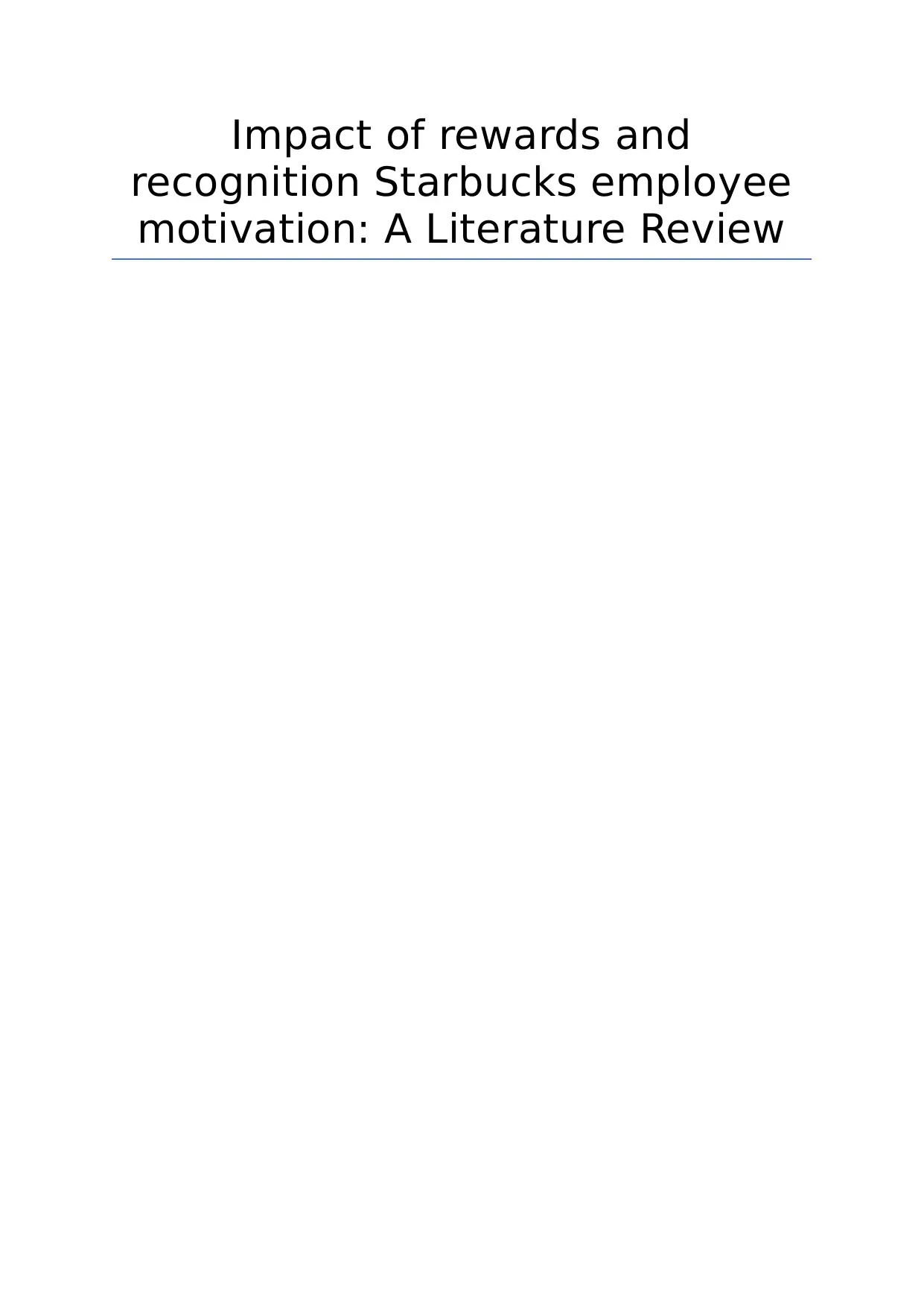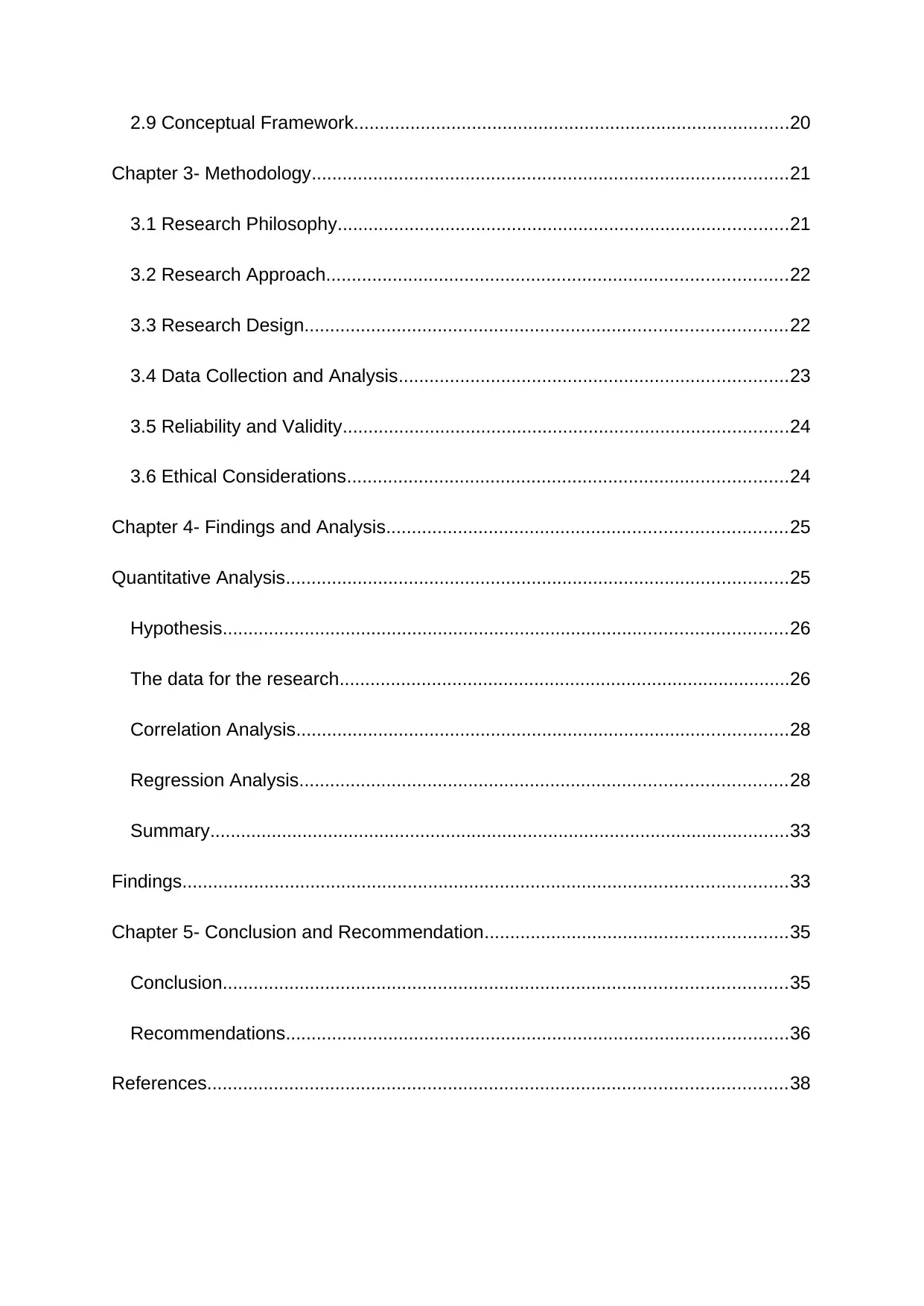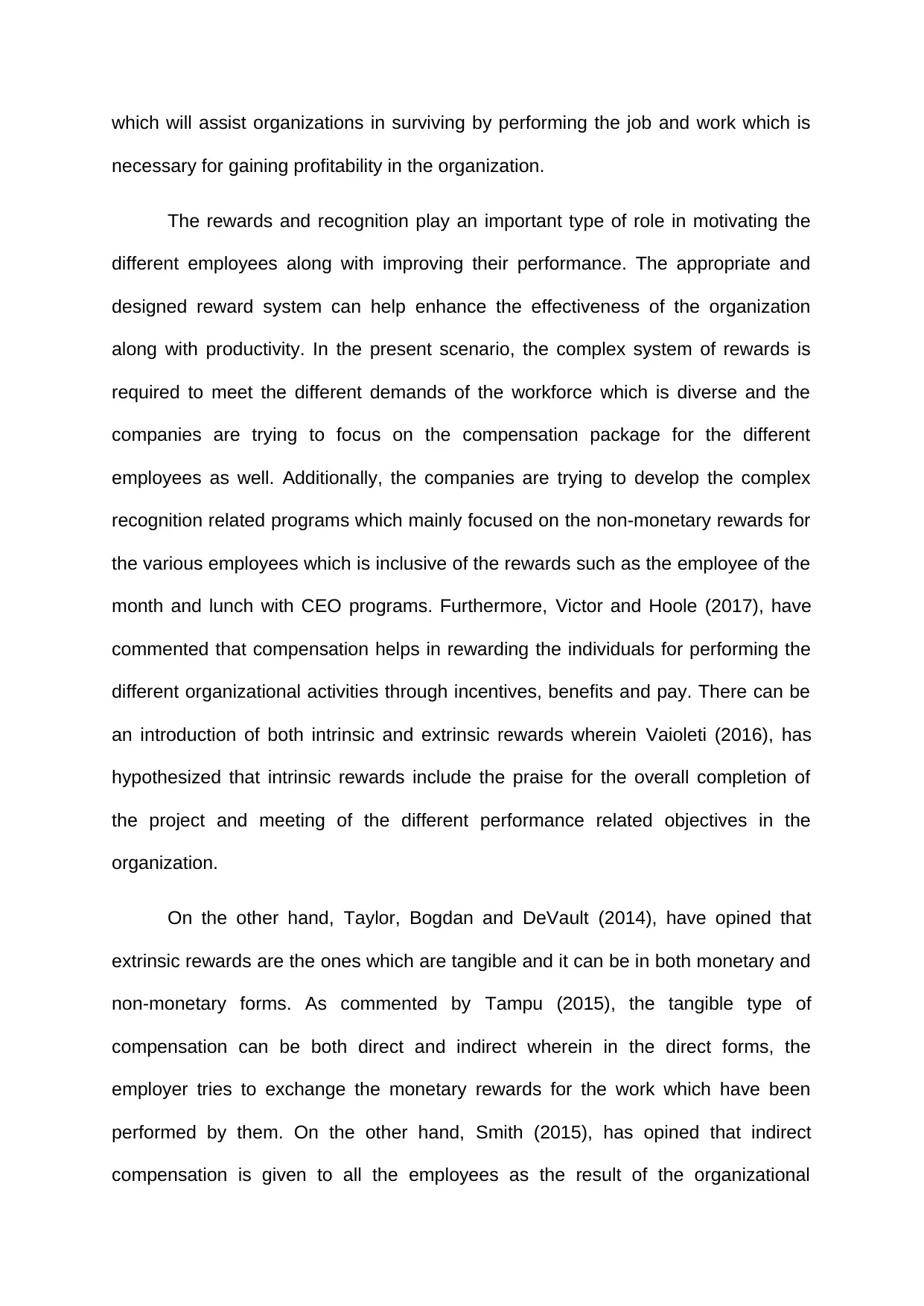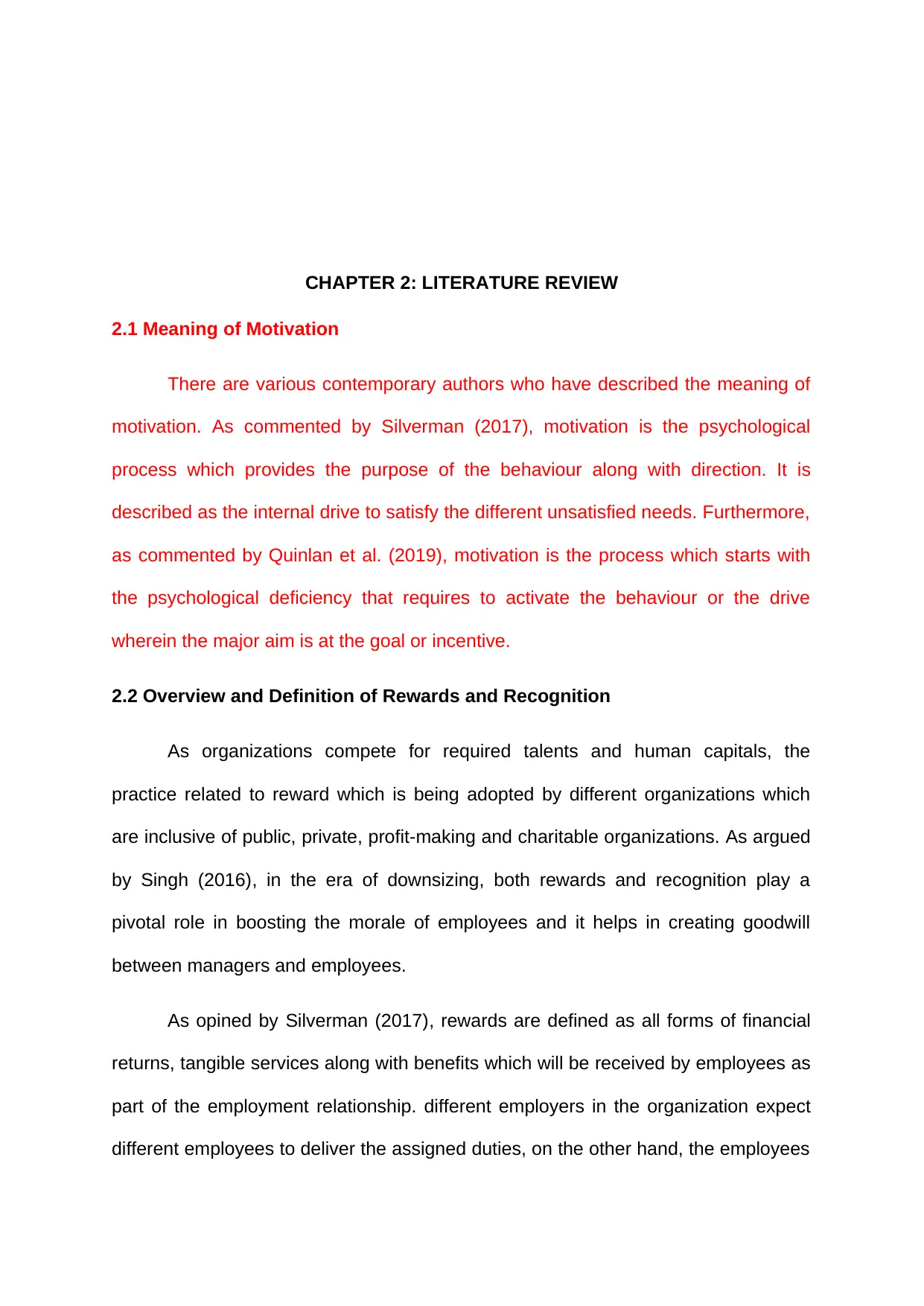Dissertation on Rewards & Recognition Impact on Starbucks Motivation
VerifiedAdded on 2023/04/21
|46
|10289
|154
Thesis and Dissertation
AI Summary
This dissertation investigates the impact of rewards and recognition on employee motivation within Starbucks. Through a comprehensive literature review and empirical analysis, it examines the correlation between reward systems, employee morale, and job satisfaction. The research delves into various motivation theories, challenges affecting reward implementation, and recommendations for utilizing rewards to enhance employee productivity. Statistical analysis, including correlation and regression, supports the hypothesis that rewards and recognition significantly influence employee performance. The study concludes with actionable recommendations for developing a functional reward system to boost employee satisfaction and overall organizational success at Starbucks. Desklib provides access to this and many other solved assignments to help students in their academic journey.

Impact of rewards and
recognition Starbucks employee
motivation: A Literature Review
recognition Starbucks employee
motivation: A Literature Review
Paraphrase This Document
Need a fresh take? Get an instant paraphrase of this document with our AI Paraphraser

Acknowledgement
I would like to take this opportunity to thank all those people who have been a great
help in completing the dissertation. These people had led me and helped me to know
my hidden potential and strength and utilize it in the best possible way in the
undertaken research. I would like to express my deep gratitude towards supervisor
for his constant monitoring and commendable and exemplary guidance, which has
led me to complete the dissertation in the due course of time.
The guidance and unconditional support provided by him not only helped me a lot
during the thesis completion but also will remain with me for a longer time period on
the journey of my life. I would like to express my deep gratitude to all the participants
who lend their valuable input to develop an understanding about impact of training
and development on the job satisfaction of the government sector employees of the
Sultanate of Oman Furthermore, I would like to thank my family and friends,
especially my dear mother and wife, who have been a constant source of Inspiration,
encouragement and support, and who they did not give up of supplication to me of
success, without which this task cannot be accomplished.
I would like to take this opportunity to thank all those people who have been a great
help in completing the dissertation. These people had led me and helped me to know
my hidden potential and strength and utilize it in the best possible way in the
undertaken research. I would like to express my deep gratitude towards supervisor
for his constant monitoring and commendable and exemplary guidance, which has
led me to complete the dissertation in the due course of time.
The guidance and unconditional support provided by him not only helped me a lot
during the thesis completion but also will remain with me for a longer time period on
the journey of my life. I would like to express my deep gratitude to all the participants
who lend their valuable input to develop an understanding about impact of training
and development on the job satisfaction of the government sector employees of the
Sultanate of Oman Furthermore, I would like to thank my family and friends,
especially my dear mother and wife, who have been a constant source of Inspiration,
encouragement and support, and who they did not give up of supplication to me of
success, without which this task cannot be accomplished.

Abstract
The research paper helps in analysing the different methods which is required as to
investigate and analyse the usage of the current reward system of the Starbucks
organization and the effect of the same on motivating the different employees
working in the organization. With the help of the literature review, the different kinds
of elements of motivating the employees have been analysed which provided a brief
overview on understanding the different kinds of theories related to motivation which
can be helpful in managing the overall aspect of motivating employees and
increasing their morale.
The empirical data which has been collected helped in analysing that there is strong
correlation between the rewards and recognition and the employee motivation which
are interrelated with one another and it will be beneficial for the overall success of
the firm. The data was received with the help of proper correlation and regression
analysis which can be helpful in comparing the different reward systems which can
be used at Starbucks as to motivate the employees and improve their productivity.
Lastly, the research helps in supporting the fact that the development of the
functional reward system will be helpful in increasing the employee satisfaction and
motivation in organization.
The research paper helps in analysing the different methods which is required as to
investigate and analyse the usage of the current reward system of the Starbucks
organization and the effect of the same on motivating the different employees
working in the organization. With the help of the literature review, the different kinds
of elements of motivating the employees have been analysed which provided a brief
overview on understanding the different kinds of theories related to motivation which
can be helpful in managing the overall aspect of motivating employees and
increasing their morale.
The empirical data which has been collected helped in analysing that there is strong
correlation between the rewards and recognition and the employee motivation which
are interrelated with one another and it will be beneficial for the overall success of
the firm. The data was received with the help of proper correlation and regression
analysis which can be helpful in comparing the different reward systems which can
be used at Starbucks as to motivate the employees and improve their productivity.
Lastly, the research helps in supporting the fact that the development of the
functional reward system will be helpful in increasing the employee satisfaction and
motivation in organization.
⊘ This is a preview!⊘
Do you want full access?
Subscribe today to unlock all pages.

Trusted by 1+ million students worldwide

Table of Contents
CHAPTER 1: INTRODUCTION....................................................................................5
1.1 Background of the research................................................................................5
1.2 Research problem...............................................................................................7
1.3 Research aim and objective...............................................................................7
1.4 Research question..............................................................................................8
1.5 Research hypothesis..........................................................................................8
1.6 Research Rationale............................................................................................8
1.7 Summary.............................................................................................................8
CHAPTER 2: LITERATURE REVIEW........................................................................10
2.1 Meaning of Motivation.......................................................................................10
2.2 Overview and Definition of Rewards and Recognition.....................................10
2.3 Linkage Between Rewards and Motivation......................................................11
2.3 Types of Rewards.............................................................................................12
2.4 Recognition of Employees................................................................................13
2.5 Job Satisfaction.................................................................................................14
2.5.1 Dimensions on Job Satisfaction.....................................................................15
2.6 Importance of Hygiene and Motivational Factors.............................................17
2.6 Link Between Rewards Strategies and Theories of Motivation........................18
2.8 Impact of rewards and recognition programs on Starbucks employee
motivation................................................................................................................19
CHAPTER 1: INTRODUCTION....................................................................................5
1.1 Background of the research................................................................................5
1.2 Research problem...............................................................................................7
1.3 Research aim and objective...............................................................................7
1.4 Research question..............................................................................................8
1.5 Research hypothesis..........................................................................................8
1.6 Research Rationale............................................................................................8
1.7 Summary.............................................................................................................8
CHAPTER 2: LITERATURE REVIEW........................................................................10
2.1 Meaning of Motivation.......................................................................................10
2.2 Overview and Definition of Rewards and Recognition.....................................10
2.3 Linkage Between Rewards and Motivation......................................................11
2.3 Types of Rewards.............................................................................................12
2.4 Recognition of Employees................................................................................13
2.5 Job Satisfaction.................................................................................................14
2.5.1 Dimensions on Job Satisfaction.....................................................................15
2.6 Importance of Hygiene and Motivational Factors.............................................17
2.6 Link Between Rewards Strategies and Theories of Motivation........................18
2.8 Impact of rewards and recognition programs on Starbucks employee
motivation................................................................................................................19
Paraphrase This Document
Need a fresh take? Get an instant paraphrase of this document with our AI Paraphraser

2.9 Conceptual Framework.....................................................................................20
Chapter 3- Methodology.............................................................................................21
3.1 Research Philosophy........................................................................................21
3.2 Research Approach..........................................................................................22
3.3 Research Design..............................................................................................22
3.4 Data Collection and Analysis............................................................................23
3.5 Reliability and Validity.......................................................................................24
3.6 Ethical Considerations......................................................................................24
Chapter 4- Findings and Analysis..............................................................................25
Quantitative Analysis..................................................................................................25
Hypothesis..............................................................................................................26
The data for the research........................................................................................26
Correlation Analysis................................................................................................28
Regression Analysis...............................................................................................28
Summary.................................................................................................................33
Findings......................................................................................................................33
Chapter 5- Conclusion and Recommendation...........................................................35
Conclusion..............................................................................................................35
Recommendations..................................................................................................36
References.................................................................................................................38
Chapter 3- Methodology.............................................................................................21
3.1 Research Philosophy........................................................................................21
3.2 Research Approach..........................................................................................22
3.3 Research Design..............................................................................................22
3.4 Data Collection and Analysis............................................................................23
3.5 Reliability and Validity.......................................................................................24
3.6 Ethical Considerations......................................................................................24
Chapter 4- Findings and Analysis..............................................................................25
Quantitative Analysis..................................................................................................25
Hypothesis..............................................................................................................26
The data for the research........................................................................................26
Correlation Analysis................................................................................................28
Regression Analysis...............................................................................................28
Summary.................................................................................................................33
Findings......................................................................................................................33
Chapter 5- Conclusion and Recommendation...........................................................35
Conclusion..............................................................................................................35
Recommendations..................................................................................................36
References.................................................................................................................38

⊘ This is a preview!⊘
Do you want full access?
Subscribe today to unlock all pages.

Trusted by 1+ million students worldwide

CHAPTER 1: INTRODUCTION
1.1 Background of the research
As the manpower constitute the core elements of the different businesses and
the employees are the major focus of the human resource management with the
different changes which are occurring in the entire world in regards with regards to
the technology along with innovation. The different business organizations try to
operate in the environment which is rarely stable in their approach. To gain a
competitive advantage in the market, the various businesses need to use the non -
imitable assets which are termed as human resources (Victor and Hoole 2017).
Furthermore, to harness the best from the different employees working in the
company, organizations need to analyze the different techniques of rewards and
recognition through which they can be motivated. Although the concept of rewards
and recognition aspect is common, however, it is involved in the approach because
the work environment is complex and it consists of the heterogeneous individuals
(Zareen, Razzaq and Mujtaba 2015).
Additionally, the different employees have a variety of needs along with
differing perceptions of the overall constitution of the rewards and recognition for
creating compelling and motivated workplace. For the respective reason, to motivate
the different employees and increase the aspects related to job satisfaction, there
should be an in-depth analysis of the individual differences along with the different
perceptions which are required for the incentives and rewards which is the
combination of both extrinsic and intrinsic motivational rewards. In addition,
motivated employees have required in the rapidly changing workplaces and markets
1.1 Background of the research
As the manpower constitute the core elements of the different businesses and
the employees are the major focus of the human resource management with the
different changes which are occurring in the entire world in regards with regards to
the technology along with innovation. The different business organizations try to
operate in the environment which is rarely stable in their approach. To gain a
competitive advantage in the market, the various businesses need to use the non -
imitable assets which are termed as human resources (Victor and Hoole 2017).
Furthermore, to harness the best from the different employees working in the
company, organizations need to analyze the different techniques of rewards and
recognition through which they can be motivated. Although the concept of rewards
and recognition aspect is common, however, it is involved in the approach because
the work environment is complex and it consists of the heterogeneous individuals
(Zareen, Razzaq and Mujtaba 2015).
Additionally, the different employees have a variety of needs along with
differing perceptions of the overall constitution of the rewards and recognition for
creating compelling and motivated workplace. For the respective reason, to motivate
the different employees and increase the aspects related to job satisfaction, there
should be an in-depth analysis of the individual differences along with the different
perceptions which are required for the incentives and rewards which is the
combination of both extrinsic and intrinsic motivational rewards. In addition,
motivated employees have required in the rapidly changing workplaces and markets
Paraphrase This Document
Need a fresh take? Get an instant paraphrase of this document with our AI Paraphraser

which will assist organizations in surviving by performing the job and work which is
necessary for gaining profitability in the organization.
The rewards and recognition play an important type of role in motivating the
different employees along with improving their performance. The appropriate and
designed reward system can help enhance the effectiveness of the organization
along with productivity. In the present scenario, the complex system of rewards is
required to meet the different demands of the workforce which is diverse and the
companies are trying to focus on the compensation package for the different
employees as well. Additionally, the companies are trying to develop the complex
recognition related programs which mainly focused on the non-monetary rewards for
the various employees which is inclusive of the rewards such as the employee of the
month and lunch with CEO programs. Furthermore, Victor and Hoole (2017), have
commented that compensation helps in rewarding the individuals for performing the
different organizational activities through incentives, benefits and pay. There can be
an introduction of both intrinsic and extrinsic rewards wherein Vaioleti (2016), has
hypothesized that intrinsic rewards include the praise for the overall completion of
the project and meeting of the different performance related objectives in the
organization.
On the other hand, Taylor, Bogdan and DeVault (2014), have opined that
extrinsic rewards are the ones which are tangible and it can be in both monetary and
non-monetary forms. As commented by Tampu (2015), the tangible type of
compensation can be both direct and indirect wherein in the direct forms, the
employer tries to exchange the monetary rewards for the work which have been
performed by them. On the other hand, Smith (2015), has opined that indirect
compensation is given to all the employees as the result of the organizational
necessary for gaining profitability in the organization.
The rewards and recognition play an important type of role in motivating the
different employees along with improving their performance. The appropriate and
designed reward system can help enhance the effectiveness of the organization
along with productivity. In the present scenario, the complex system of rewards is
required to meet the different demands of the workforce which is diverse and the
companies are trying to focus on the compensation package for the different
employees as well. Additionally, the companies are trying to develop the complex
recognition related programs which mainly focused on the non-monetary rewards for
the various employees which is inclusive of the rewards such as the employee of the
month and lunch with CEO programs. Furthermore, Victor and Hoole (2017), have
commented that compensation helps in rewarding the individuals for performing the
different organizational activities through incentives, benefits and pay. There can be
an introduction of both intrinsic and extrinsic rewards wherein Vaioleti (2016), has
hypothesized that intrinsic rewards include the praise for the overall completion of
the project and meeting of the different performance related objectives in the
organization.
On the other hand, Taylor, Bogdan and DeVault (2014), have opined that
extrinsic rewards are the ones which are tangible and it can be in both monetary and
non-monetary forms. As commented by Tampu (2015), the tangible type of
compensation can be both direct and indirect wherein in the direct forms, the
employer tries to exchange the monetary rewards for the work which have been
performed by them. On the other hand, Smith (2015), has opined that indirect
compensation is given to all the employees as the result of the organizational

membership. Smith, Joubert and Karodia (2015), have defined that well-defined
motivation is the kind of force which pushes the employees in performing the tasks
through proper inspiration and there can be the inclusion of both monetary and non-
monetary rewards.
1.2 Research problem
From the different annual reports of Starbucks, it has been identified that the
morale of the staffs working at Starbucks is considerably low and it has decreased
the overall productivity of the organization negatively. Hence, the main aspect in the
research is to identify the different techniques to improve the morale of the
employees working at Starbucks. It has been noticed that there is a lack of
motivation provided to employees which are required to be addressed in the
respective research paper.
1.3 Research aim and objective
The primary main aim of the research is to analyse the relationship between
rewards and recognition and the effect of the same on the performance of the
employees working at Starbucks. The study will further analyse the different
motivation theories along with approaches which will be commonly utilized and in
order to achieve the aims, the different objectives are as follows:
To analyse the reasons for motivating employees in the organization
To examine the overall impact of the impact of rewards and recognition
programs on Starbucks employee motivation
To assess the relationship between the rewards and recognition and job
satisfaction among employees
motivation is the kind of force which pushes the employees in performing the tasks
through proper inspiration and there can be the inclusion of both monetary and non-
monetary rewards.
1.2 Research problem
From the different annual reports of Starbucks, it has been identified that the
morale of the staffs working at Starbucks is considerably low and it has decreased
the overall productivity of the organization negatively. Hence, the main aspect in the
research is to identify the different techniques to improve the morale of the
employees working at Starbucks. It has been noticed that there is a lack of
motivation provided to employees which are required to be addressed in the
respective research paper.
1.3 Research aim and objective
The primary main aim of the research is to analyse the relationship between
rewards and recognition and the effect of the same on the performance of the
employees working at Starbucks. The study will further analyse the different
motivation theories along with approaches which will be commonly utilized and in
order to achieve the aims, the different objectives are as follows:
To analyse the reasons for motivating employees in the organization
To examine the overall impact of the impact of rewards and recognition
programs on Starbucks employee motivation
To assess the relationship between the rewards and recognition and job
satisfaction among employees
⊘ This is a preview!⊘
Do you want full access?
Subscribe today to unlock all pages.

Trusted by 1+ million students worldwide

To identify the different challenges which can be affecting rewards and
recognition provided to employees
To recommend the manner in which the rewards can be utilized as a tool to
motivate employees and increase productivity
1.4 Research question
The research questions which are required to be analysed in the respective
research paper are as follows:
What is the impact of the rewards and recognition on the performance of
employees in the organization?
1.5 Research hypothesis
Based on the different objectives, the following hypothesis was proposed
which are as follows:
H1- Rewards and Recognition can create a huge impact on the performance of
employees
H0- Rewards and Recognition cannot create an impact on the performance of
employees
1.6 Research Rationale
After the overall analysis of the research study, the main aim and purpose of
the paper are to analyse the overall influence of the rewards and recognition on
employee performance. The primary purpose of the article is to identify the
application of the different awards such as both monetary and non-monetary rewards
on motivating employees which can be both positive or negative.
recognition provided to employees
To recommend the manner in which the rewards can be utilized as a tool to
motivate employees and increase productivity
1.4 Research question
The research questions which are required to be analysed in the respective
research paper are as follows:
What is the impact of the rewards and recognition on the performance of
employees in the organization?
1.5 Research hypothesis
Based on the different objectives, the following hypothesis was proposed
which are as follows:
H1- Rewards and Recognition can create a huge impact on the performance of
employees
H0- Rewards and Recognition cannot create an impact on the performance of
employees
1.6 Research Rationale
After the overall analysis of the research study, the main aim and purpose of
the paper are to analyse the overall influence of the rewards and recognition on
employee performance. The primary purpose of the article is to identify the
application of the different awards such as both monetary and non-monetary rewards
on motivating employees which can be both positive or negative.
Paraphrase This Document
Need a fresh take? Get an instant paraphrase of this document with our AI Paraphraser

1.7 Summary
From the overall analysis of the topic, it can be identified that the awards and
recognition play a vital role in improving the overall morale of employees and it will
increase the overall productivity of the organization Starbucks. The research
questions have been identified which will assist in understanding the overall positive
along with negative approaches of the motivation on the performance of employees.
From the research hypothesis, it has been recognized that there can be the inclusion
of null and alternate hypothesis which can create a significant impact on the
performance of employees and it can affect the overall performance of the
organization in both positive or negative manner as well in the future.
From the overall analysis of the topic, it can be identified that the awards and
recognition play a vital role in improving the overall morale of employees and it will
increase the overall productivity of the organization Starbucks. The research
questions have been identified which will assist in understanding the overall positive
along with negative approaches of the motivation on the performance of employees.
From the research hypothesis, it has been recognized that there can be the inclusion
of null and alternate hypothesis which can create a significant impact on the
performance of employees and it can affect the overall performance of the
organization in both positive or negative manner as well in the future.

CHAPTER 2: LITERATURE REVIEW
2.1 Meaning of Motivation
There are various contemporary authors who have described the meaning of
motivation. As commented by Silverman (2017), motivation is the psychological
process which provides the purpose of the behaviour along with direction. It is
described as the internal drive to satisfy the different unsatisfied needs. Furthermore,
as commented by Quinlan et al. (2019), motivation is the process which starts with
the psychological deficiency that requires to activate the behaviour or the drive
wherein the major aim is at the goal or incentive.
2.2 Overview and Definition of Rewards and Recognition
As organizations compete for required talents and human capitals, the
practice related to reward which is being adopted by different organizations which
are inclusive of public, private, profit-making and charitable organizations. As argued
by Singh (2016), in the era of downsizing, both rewards and recognition play a
pivotal role in boosting the morale of employees and it helps in creating goodwill
between managers and employees.
As opined by Silverman (2017), rewards are defined as all forms of financial
returns, tangible services along with benefits which will be received by employees as
part of the employment relationship. different employers in the organization expect
different employees to deliver the assigned duties, on the other hand, the employees
2.1 Meaning of Motivation
There are various contemporary authors who have described the meaning of
motivation. As commented by Silverman (2017), motivation is the psychological
process which provides the purpose of the behaviour along with direction. It is
described as the internal drive to satisfy the different unsatisfied needs. Furthermore,
as commented by Quinlan et al. (2019), motivation is the process which starts with
the psychological deficiency that requires to activate the behaviour or the drive
wherein the major aim is at the goal or incentive.
2.2 Overview and Definition of Rewards and Recognition
As organizations compete for required talents and human capitals, the
practice related to reward which is being adopted by different organizations which
are inclusive of public, private, profit-making and charitable organizations. As argued
by Singh (2016), in the era of downsizing, both rewards and recognition play a
pivotal role in boosting the morale of employees and it helps in creating goodwill
between managers and employees.
As opined by Silverman (2017), rewards are defined as all forms of financial
returns, tangible services along with benefits which will be received by employees as
part of the employment relationship. different employers in the organization expect
different employees to deliver the assigned duties, on the other hand, the employees
⊘ This is a preview!⊘
Do you want full access?
Subscribe today to unlock all pages.

Trusted by 1+ million students worldwide
1 out of 46
Related Documents
Your All-in-One AI-Powered Toolkit for Academic Success.
+13062052269
info@desklib.com
Available 24*7 on WhatsApp / Email
![[object Object]](/_next/static/media/star-bottom.7253800d.svg)
Unlock your academic potential
Copyright © 2020–2025 A2Z Services. All Rights Reserved. Developed and managed by ZUCOL.





